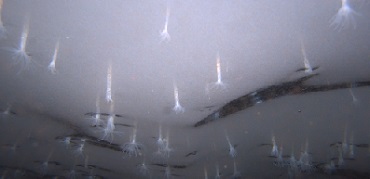SATS-108-ice anemones.jpg

Anemones protruding from the bottom surface of the Ross Ice Shelf. Credit: Frank R. Rack, ANDRILL Science Management Office, University of Nebraska-Lincoln.
A species recently discovered in the Antarctic is the anemone equivalent of a bat: it hangs upside down, from the underside of a massive sheet of ice.
In 2013, researchers were testing out a new remotely operated vehicle — a small set of cameras and other instruments at the end of a long cable. The ROV (remotely operated vehicle) was designed to explore waters below the Antarctic ice, which is hundreds of feet thick.
They dropped the ROV down a hole they melted in the Ross Ice Shelf, a slab that extends hundreds of miles from Antarctica. When its cameras looked up, the bottom of the ice looked fuzzy. And when the scientists moved the vehicle in for a closer look, they saw hundreds of tiny creatures extending their tentacles into the water.
Those creatures were anemones — the first ever found living in ice. Most anemones live in soft ocean sediments, although a few are found in crevices in rocks or in the shells of dead corals.
The new Antarctic anemones are tiny — less than an inch long. They wedge their bodies in cracks and pits in the ice, with their tentacles waving in the water. They use the tentacles to nab bits of organic debris floating along with the current.
One patch of the little critters covered about a thousand square feet — the size of a house. A second patch was found a few miles away, near another hole in the ice. And the researchers have speculated that the anemones could extend across many miles — potentially millions of “vampire anemones” hanging from the Antarctic ice.

